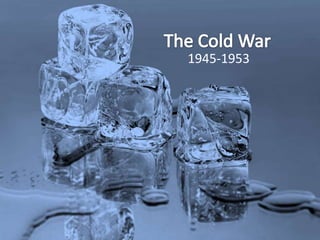
Beginnings of the Cold War - Cold War I
- 1. 1945-1953
- 2. The Cold War • An era of high tension and rivalry between the United States and the Soviet Union
- 3. World War II Alliance • U.S. and Soviet Union were allies during WWII, not friends • U.S. provided military equipment to Soviets after Hitler’s invasion in 1941 through the Lend-Lease program • U.S. often promised to defend Soviet Union, but never delivered and hard feelings increased • Mistrust about the atomic bomb led Soviets to develop their own.
- 4. The Iron Curtain Descends • During the Yalta and Potsdam conferences, the U.S. and Britain pressed Stalin to hold free elections in Soviet occupied lands ex. Poland • Stalin had no intention of giving up political or economic control of Eastern Europe • Stalin wanted to increase security for his country by creating a line of Soviet-friendly nations around it
- 5. Communism Spreads • Did whatever it took to install Communist governments in these E. European countries – Outlawed political parties, newspapers opposing Communists – Killed, jailed opponents, rigged elections • Took over and directly controlled every Eastern European nation except Yugoslavia • U.S. also concerned about Soviet brutal relocation of Germans living in E. Europe
- 6. “The Iron Curtain” • “A shadow has fallen upon the scenes so lately lighted by the Allied victory. Nobody knows what Soviet Russia and its Communist international organization intends to do in the immediate future, or what are the limits, if any, to their expansive… tendencies… It is my duty to place before you certain facts about the present position of Europe. From Stettin in the Baltic to Trieste in the Adriatic, an iron curtain has descended across the continent.” – Winston Churchill in Fulton, Missouri, March 5, 1946
- 7. The U.S. Responds • United States adopted the containment policy – Created by George F. Kennan – Included: possibility of using military force, providing economic aid to countries • 1947 – Truman asked Congress for emergency economic and military aid for Greece & Turkey • Truman Doctrine – a speech urging Congress to help stop Soviets from gaining control
- 8. The Truman Doctrine “I believe it must be the policy of the United States to support free peoples who are resisting subjugation by armed minorities or outside pressures… I believe that our help should be primarily through economic and financial aid which is essential to economic stability and orderly political processes.” -President Harry S. Truman, March 12, 1947
- 9. The Marshall Plan • WWII was over, but Europeans still suffered • Americans knew if conditions worsened, more Europeans might turn to communism • June 1947, George C. Marshall called for an aid program to help Europe rebuild known as the Marshall Plan – 1948-51, the U.S. spent $13 billion in 17 countries • Provided food, farm equipment, rebuilt homes, factories • Helped U.S. build political support in W. Europe
- 10. The Crisis in Berlin • U.S., France and Britain zones - Democratic • Soviet zone –Communist • The capital of Berlin (located in Soviet zone) also divided into 4 zones • June 1948 - Soviet’s blocked all traffic into W. Berlin – 2.1 million people were cut off from basic resources
- 11. The Berlin Airlift • American and British airplanes dropped necessities to W. Berlin • Average 7,000 tons of supplies dropped/day • May 12, 1949 Soviet Union lifted its blockade • Between June 1948 and May 1949 - 280,000 flights were made
- 12. The Berlin Airlift A stamp commemorating the event.
- 13. NATO • 1948 – Belgium, France, Luxembourg, Netherlands and the UK joined together in a system of common defense • April 1949 – These countries, U.S., and 6 more countries formed a military alliance - NATO – North Atlantic Treaty Organization – An attack on one member, was an attack on all
- 14. Postwar America • 12 million men and women returned to civilian life – Jobs not always available – Women pressured to leave their jobs
- 15. Life in Postwar America • June 1944 Roosevelt signed Serviceman’s Readjustment Act aka the GI Bill, it provided veterans with: – Money to attend college, receive job training – Loans to buy homes, farms, businesses – Help finding work – A year of unemployment benefits for those who couldn’t
- 16. Life in Postwar America • Demand for consumer goods rose sharply • More Americans began having families – Baby Boom – dramatic rise in birthrate • Labor unions began seeking wage increases – Taft-Hartley Act – reduced power of unions • President Truman issued Executive Order 9981 – Ended segregation in the U.S. armed forces • Hispanic Americans worked to win full access to GI Bill benefits they earned for their service
- 17. Postwar Politics • Harry S Truman had been VP barely 2 months when Roosevelt died – Knew little about issues/decisions the nation faced – Criticized by Democrats and Republicans alike • Key complaint: inflation – rise in prices (that had been controlled by the government during the war) • 1946 Congressional election – Republicans became majority for the first time since 1930 – More difficult for Truman to put programs in place
- 18. Postwar Politics • 1948 election – Democrats split their support – Henry Wallace – running w/ Progressive Party – Strom Thurmond – Dixiecrat, attracted voters who opposed Truman’s support for civil rights • Truman set off on a whirlwind campaign across the U.S., but most people ruled him out • Beat out Thomas E. Dewey for the presidency in one of the most surprising elections ever
- 19. •Truman now felt strong enough to create his own plan for the country known as the Fair Deal that included: •Federal health insurance program •Funding for education • Not supported by Congress
- 20. For Next Class…